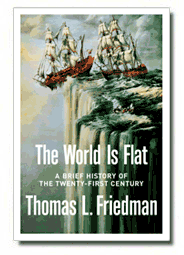The World Is Flat - Worth a read!
The World Is Flat: A Brief History of the Twenty-first Century is a best-selling book by Thomas L. Friedman analyzing the progress of globalization with an emphasis on the early 21st century. It was first released in 2005 and was later released as an "updated and expanded" edition in 2006.
Overview
Friedman believes the world is flat in the sense that the competitive playing fields between industrial and emerging market countries are leveling. Friedman recounts many examples in which companies in
In Chapter 11, "The Unflat World," Friedman discusses his philosophy of history: "I am a technological determinist! . . . I believe that capabilities create intentions. . . . But . . I am not a historical determinist". He notes that there are still three billion people who still live in an "unflat world" unaffected by the technologies and socioeconomic changes, sometimes this is caused by poverty. He addresses what these three billion people--as well as their governments and the world's businesses--need to do in order to join the "flat world."
Criticism
The central image of the book―the "flat" world―has been criticized by The Economist as an "inaccurate and empty image" that does not suit Friedman's own argument. While Friedman points out that the world is increasingly inter-connected, his image may suggest the opposite, as a flat world would be harder to navigate than a spherical one. However, Friedman more likely meant the metaphor to imply the "playing field is flat" in the competitive sense.
There has also been criticism of Friedman's use of the flat earth theory in his book. Friedman perpetuates the myth that Christopher Columbus set out to prove the world was round, while his contemporaries believed it was flat and that his ships would sail off the edge of the Earth. This false idea was begun by a biography of
Peak oil advocate James Howard Kunstler believes that the globalization model supported by Thomas Friedman is a "false doctrine" because it relies on cheap oil and implies a growth of its use, and in a century to be sealed by future oil depletion and global warming it is nor sustainable nor desirable.
~~
Corporate Study Team,
IMERT, Pune
Labels: The World Is Flat















3 Comments:
I am a first-year MBA student at Vanderbilt University and each of the students of the incoming class got "The World is Flat" by FedEx with a handwritten note from Dean Jim Bradford (www.deanbradford.com)
During orientation we had many small group discussions regarding the book and it fit well into our Corporate Social Responsibility (CSR) course. Some of our best faculty took the day to spend with the students and speak about the "flattening" of the world... if I only I had a nickel for every time they said "flattening!"
Visit our blogs at www.owenbloggers.com
How did you hear about the book being a part of our curriculum anyway?
Well, thank you for visiting our blog Sharran and it was very nice to leave a comment.
The book was referred to us by all most all our faculty members.
It is not a part of our curriculum, and being first year students, the schedule designed for us does not really allow us to go through all the reference books!
One of my colleagues spoke about the books in his presentations to the class. Since then all 20 copies of the book are missing from the library!
~~
Varun Nagpal
System Cell,
IMERT, Pune
It sure is worth a read... we have it as a part of our curriculum too!!
Rohit,
IIMB
Post a Comment
<< Home